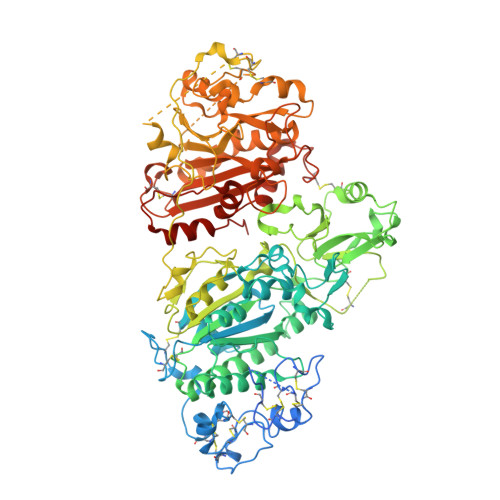Discovery, Structure-Activity Relationship, and Binding Mode of an Imidazo[1,2-a]pyridine Series of Autotaxin Inhibitors.
Joncour, A., Desroy, N., Housseman, C., Bock, X., Bienvenu, N., Cherel, L., Labeguere, V., Peixoto, C., Annoot, D., Lepissier, L., Heiermann, J., Hengeveld, W.J., Pilzak, G., Monjardet, A., Wakselman, E., Roncoroni, V., Le Tallec, S., Galien, R., David, C., Vandervoort, N., Christophe, T., Conrath, K., Jans, M., Wohlkonig, A., Soror, S., Steyaert, J., Touitou, R., Fleury, D., Vercheval, L., Mollat, P., Triballeau, N., van der Aar, E., Brys, R., Heckmann, B.(2017) J Med Chem 60: 7371-7392
- PubMed: 28731719
- DOI: https://doi.org/10.1021/acs.jmedchem.7b00647
- Primary Citation of Related Structures:
5M7M - PubMed Abstract:
Autotaxin (ATX) is a secreted enzyme playing a major role in the production of lysophosphatidic acid (LPA) in blood through hydrolysis of lysophosphatidyl choline (LPC). The ATX-LPA signaling axis arouses a high interest in the drug discovery industry as it has been implicated in several diseases including cancer, fibrotic diseases, and inflammation, among others. An imidazo[1,2-a]pyridine series of ATX inhibitors was identified out of a high-throughput screening (HTS). A cocrystal structure with one of these compounds and ATX revealed a novel binding mode with occupancy of the hydrophobic pocket and channel of ATX but no interaction with zinc ions of the catalytic site. Exploration of the structure-activity relationship led to compounds displaying high activity in biochemical and plasma assays, exemplified by compound 40. Compound 40 was also able to decrease the plasma LPA levels upon oral administration to rats.
Organizational Affiliation:
Galapagos SASU , 102 Avenue Gaston Roussel, 93230 Romainville, France.























